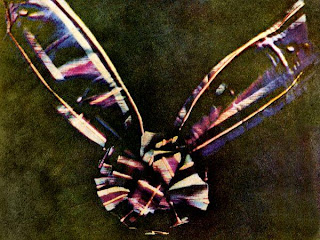FIRST PHOTO EVER CAPTURE
Centuries of advances in chemistry and optics, including the invention of the camera obscura, set the stage for the world’s first photograph. In 1826, French scientist Joseph Nicéphore Niépce, took that photograph, titled View from the Window at Le Gras, at his family’s country home. Niépce produced his photo—a view of a courtyard and outbuildings seen from the house’s upstairs window—by exposing a bitumen-coated plate in a camera obscura for several hours on his windowsill.
FIRST COLOR PHOTO
Best known for his development of electromagnetic theory, Scottish physicist James Clerk Maxwell dabbled in color theory throughout his life, eventually producing the first color photograph in 1861. Maxwell created the image of the tartan ribbon shown here by photographing it three times through red, blue, and yellow filters, then recombining the images into one color composite
FIRST UNDERWATER PICTURE
Underwater color photography was born with this shot of a hogfish, photographed off the Florida Keys in the Gulf of Mexico by Dr. William Longley and National Geographic staff photographer Charles Mar... more
This flashlight photograph of a white-tailed doe with her fawns was among the world’s first nighttime photographs of animals, shot by photographer and wildlife enthusiast George Shiras. A pioneer in flashlight and trip-wire photography, Shiras captured this shot in Whitefish River, Michigan, around 1906, using a remote-control flashlight camera triggered when an animal stepped on the trip wire.
FIRST FLASHLIGHT PICTURE
This flashlight photograph of a white-tailed doe with her fawns was among the world’s first nighttime photographs of animals, shot by photographer and wildlife enthusiast George Shiras. A pioneer in flashlight and trip-wire photography, Shiras captured this shot in Whitefish River, Michigan, around 1906, using a remote-control flashlight camera triggered when an animal stepped on the trip wire.
The settling of a debate—whether, during its gait, all four of a horse's hooves are simultaneously off the ground—first spurred English photographer Eadweard Muybridge in 1872 to look for a way to capture the sequence of movement. It took six years, but in 1878, Muybridge succeeded. He arranged 12 trip-wire cameras along a racetrack in the path of a galloping horse. The resulting photo sequence proved that there is a point when no hooves touch the ground and set the stage for the first motion pictures
FIRST TORNADO PICTURE
An unknown photographer inspired legions of tornado-chasers when he captured the earliest known photograph of a tornado. The black-and-white image was taken on August 28, 1884, about 22 miles (45 kilometers) southwest of Howard, South Dakota.
FIRST PICTURE OF NORTH-POLE
In April 1909, Admiral Robert Peary and his team (pictured here), including Inuits Ooqeah, Ooatah, Egingwah, and Seeglo and fellow American Matthew Henson, became the first explorers to reach what they believed to be the North Pole. Later studies found that Peary was actually 30 to 60 miles (50 to 100 kilometers) short of the Pole.
BEST PICTURE
When he wandered into an Afghan refugee camp in Pakistan in December 1984, National Geographic photographer Steve McCurry captured one of the most famous portraits the world had ever seen. The Afghan girl with the haunting green eyes captivated everyone. That captivation proved, once again, the power of photography to open eyes—and hearts and minds—with a single image. McCurry's portrait, which appeared on the cover of National Geographic in June 1985, was shot on Kodachrome film, a relationship that lasted for decades. In June 2009, Kodak announced it was retiring the film line and asked McCurry to shoot one of the last Kodachrome rolls. The photographs from that roll will be donated to the George Eastman House museum in Rochester, New York.








No comments:
Post a Comment